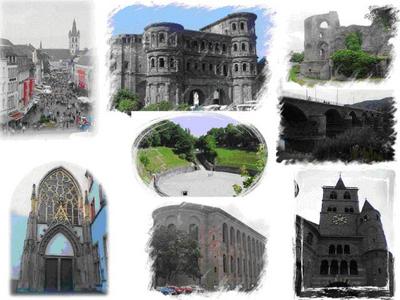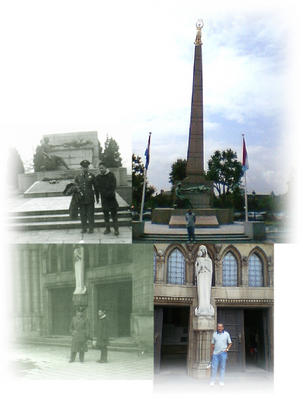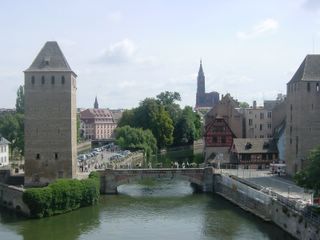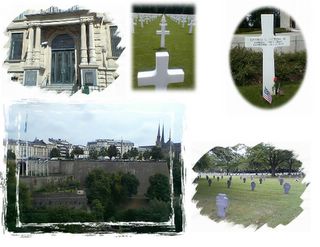Katalinaz Place
"...Far away places...with strange sounding names...Far away over the sea. Those Far away places are calling to me...just calling...calling, me." "...it is not the destination, but who is beside you that counts..."
Tuesday, August 30, 2005
Strasbourg, France
Our FIRST adventure and travel to France was to Strasbourg. This French City is located in Alsace and is only about a three our drive from our home in Germany.
We started out at “Oh-Dark-Thirty” so as to beat the traffic on the German Autobahns. Just before the border of France, we saw signs for a local Saturday flea market. Since we made good travel time, we decided to stop and see what “treasures” the market had to offer.
My husband, ever on the hunt for militaria, found a vendor with some excellent old photographs of German soldiers, circa 1930’s to 1940’s. For myself, I found a couple of pieces of the Bavarian White porcelain of which I can never have enough! With my limited Deutesche and even less spoken French, I managed...or so I thought to haggle for good prices!
Then it was on to Strasbourg. which was only about 10 minutes away from the flea market location.
As this was a “Day Trip” we decided to head straight for Strasbourg’s Notre Dame, which was located in the center of the town. This Cathedral was the touted to be the tallest structure in Christendom until the 19th century when the Cathedrals in Ulm and Cologne were built. We were very much amazed at the intricate carvings and “lace-like” appearance of the stenciled arcades! The interior of the Cathedral contains many beautiful pieces of artwork, stained glass windows, and Angelic carvings. There is even the famous Astronomical Clock located inside the south side of the Cathedral. This clock has a Copernican planetary system as well as an ecclesiastical calendar! Everyday at 1230, automated figures from within the clock, parade before those who are watching. These figures parade before Christ who blesses them three times before blessing the crowd. There are other wonderful attributes to this clock and we are still amazed at how such an item could have been built during the late 16th century! Being adventurous (?)...we decided to climb the 300+ steps to the viewing platform! After MANY rests on our way to the top, we were not disappointed with the view that awaited us once we reached the platform! Quelle vue à voir ! (What a sight to behold!) The entire city view was ours!
After our descent from the Cathedral’s viewing platform, we decided to get a bite to eat and chose a bistro which offered outside seating affording us a view of passersby. Now you would think since we were in France that we would pick dishes that were peculiar to the region...well, we did and we didn’t! My husband dined on scallops served over a pasta and I chose (you will love this!), Quiche Lorraine! But...I must say the dishes we chose were delectable! Si manifique! The Quiche melted in my mouth as did the crust! Between the wine, the bread, the salad and the main course for lunch...we even “forced” ourselves to stop about fifteen minutes AFTER the meal to have Cappuccino and desserts!
Of course, we had to “walk” off the lunch and desserts and Strasbourg is exactly the city in which to do this. Strasbourg was built over the Ill River. There are canals, which are “tributaries” of the Ill. These canals run thru Strasbourg and offer viewers the opportunity to view the city as it should be seen—on foot. We crossed the canals/river through Ponts Couvert (covered bridges), we strolled thru Petit France. Many of the small doorways on the residences and buisinesses have dates etched above the archways. Some that we saw were 1597, 1572, etc. The Ponts Couvert and the four towers which were a part of the City's fortification built in about 1230-1250. Four of the 80 towers are still standing and are in perfect condition!
Our day was coming to an end and what better way to finish our walking tour of the City than to have “One for the Road”!!! No! Not alcohol...but some refreshing mineral water!
We will definitely return to this beautiful city that reminded us so much of Venice—only on our next return...we will stay a little longer so that we may linger over more wine and more local cuisine!
Wednesday, August 24, 2005
Schloß Solitude
Another short drive from our home is Schloss Solitude. The Solitude Palace was built in late Baroque style by Duke Carl Eugen between 1763 and 1767 and was completely renovated between 1972-83.
The Schloss’ grounds offer the visitor a restful place to come and enjoy the large grassy area that is located between the Palace and a panoramic view of the Stuttgart area. While we were there, we saw folks enjoying a warm summer day, picnicing, reading, etc. Visitors such as my husband and I, simply enjoy the architecture, the grounds, and the beautiful view!
Also on the grounds are the Officers’ and the Cavaliers’ buildings which has “housed” the 'Akademie Schloss Solitude' since 1990. This “Akademie” serves to encourage young and talented artists.
Ludwigsburg Castle
There is always “somewhere” to go here in Deutscheland! A short drive from our home in Aichtal is Ludwigsburg and home to one of King Ludwig’s castles”.
The drive is short, pleasant, and a good excuse to stop at the local eatery and have a bite to eat (especially after an exhausting tour!) ...Well maybe not exhausting...
Trier - Germany's Oldest City

We took an “extended weekend” trip to the German city of Trier. The travel guides and online website touts this city as being the “...oldest City of Germany...” Indeed Trier spans two millenia! We chose to visit this city because of its location (strategic and military), its history, and the Roman ruins.
We did indeed see Roman ruins! One of these included the Porta Nigra which is known as one of the “biggest and best preserved” Roman ruins in northern Europe. We stayed at the Zum Christophel Hotel which afforded us a primo view of the Porta Nigra from our hotel room window. Upon awaking each morning (without even having to get up out of bed!) we could look up and see the Porta Nigra! (Talk about “touring without effort!) We also did a walking tour of Trier and visited the brick Konstantinsbasilika, (which is said to be; apart from the Pantheon in Rome...the biggest enclosed space to survive from the days of antiquity). We also saw the the Kaiserthermen (Imperial Baths). It’s amazing to see the height of the structure that is still standing! We visited the Roman Amphitheater which is still used to this day—uh—not for “Gladitatorial” uses as it once was in the past, but for concerts and more “peaceful” type functions!!!
We also viewed the ancient Roman bridge which spans the Mosel River. World War II--General Patton’s tanks captured this bridge so quickly that during the capture, they did not have to “blow” the bridge up as originally planned. In fact, the empty charge chambers can still be seen from the up-river side of the bridge! Today, this bridge is in tact and open to pedestrian and automobile traffic.
We especially enjoyed strolling in the “Hauptmarkt” which is the main market and shopping area. This pedestrian zoned area has access to the Cathedral and the Jewish Quarter. There are many colorful and historic homes and buildings located in this area. In the evening, the Hauptmarkt comes alive with outdoor restaurants, cafes, and bier gartens.
As mentioned earlier, the hotel we stayed at was the Hotel Zum Christophel. This hotel is ideally located directly across from the Porta Nigra and is situated perfectly for touring the Hauptmarkt! The breakfasts (included) were excellent and in the typical European style. There was also a charming outdoor dining area/bier garten for taking your dinner and/or coffee and dessert in the evening. We highly recommend this property for your stay in Trier!
All in all, we had a lovely visit to this ancient city and region and look forward to returning for the annual Wein Festival!
Again, it is always a wonder to us (since coming to live/work in Europe), that no matter where we go or visit, we “trod” on such historical locations which played a profound role in history!
Grand Duche de Luxembourg
 This first set of photos are the "Then" and "Now" set that show a couple of locations that my husband had visited with his father during the early 60’s.
This first set of photos are the "Then" and "Now" set that show a couple of locations that my husband had visited with his father during the early 60’s.The FIRST TWO is of Gëlle Fra” Memorial: set up in 1923 to commemorate the Luxembourgers who perished in the First World War.
The SECOND SET is in front of the Cathedral to the Blessed Virgin.
 Above is the Deer Crossing mentioned later on in the narrative.
Above is the Deer Crossing mentioned later on in the narrative.The drive from Trier to Luxemborg was ideallic in that the weather was beautiful and the traffic—nonexistent! That is to say, no German “Stau” to contend with! We particularly enjoyed seeing the numerous “deer crossing(s)” (see photo above) which stretched overhead from one side of the highway to the other side. What was particularly interesting about these crossings was that they were “landscaped”! (The USA deer should be so lucky!)
The city of Luxemborg was quite interesting. We first noticed that there were banks everywhere! (After further research, I found that Luxembourg plays a major role in the international financial world. Indeed, there are over 220 banks which represents the greatest number concentrated in one area than all others in the European communities! Also listed are more than 14,000 domiciled Holding Companies as well as some 1,300 Investment Funds!) Hmmm...and I thought the Swiss banks ruled!
Historically, Lucilinburhuc (Luxembourg) started in the year 963. The founder of the Luxembourg Dynasty, Siegfried (Count of the Ardennes) built a castle on the area which is now present day capital of Luxembourg. Despite Luxembourg’s “neutrality” status, the country was occupied by German troops twice during the two World Wars. The Battle of the Bulge was to a great extent fought on Luxembourg soil.
Since we were on a “short” day excursion, our time was limited in the city of Luxembourg itself, as we wanted to also visit the American Military Cemetary and pay our respects to the soldiers that perished during the second World War. Also at this cemetary is the gravesite of General Patton.
Interestingly enough, as we were leaving the American Military Cemetary, we came upon signs that led to the German Military Cemetary as well. We decided to visit this cemetary and pay respects to the “soldier(s)” who also perished in the second World War. (Note: we did not pay homage “Germany’s soldiers”, rather we showed our respect for the “soldier” in general--such a sad thought (on both sides), that so many perished...). The visit to both cemetaries was humbling to say the least.







